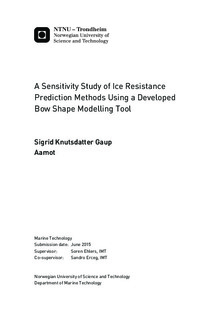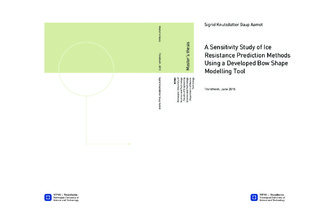| dc.description.abstract | The shipping in ice-covered waters increases the need of knowledge and understanding about physical effects of the icebreaking process during the ship-ice interaction. The shape of the ship bow will affect the ice resistance significantly and thus it is important to consider its geometry when predicting the ice resistance. The ice resistance on ships advancing in level ice can be predicted by either performing model tests or applying methods estimating the ice resistance.
The aim of this thesis is to perform a sensitivity analysis of chosen ice resistance prediction methods with regard to the bow shape and thus identify the effect of the bow geometry on the breaking resistance. The desired bow shapes are generated through a parametric 3D model developed in MATLAB.
The parametric 3D model is built up by a "bow skeleton" which consists of a mesh grid with connected control points that depend on bow length, ship beam, ice thickness and five angles describing the bow shape. To obtain a 3D bow shape, a surface was added made up by non-uniform rational basis splines. By adjusting the control points, a desired bow shape can be generated. For simplicity, the model is only considering the ice belt area.
%The bow angles are described by two waterline entrance angles, two frame angles, and buttock angle at stem.
A sensitivity analysis was performed on the methods of \cite{Lindqvist_1989} and \cite{Erceg_etAl_2014} with regard to the bow geometry as they both are considering the same parameters describing the bow shape angles, and the methods are decomposing the ice resistance to be able to estimate the resistance components separately. The method of Lindqvist was found to be more sensitive to larger buttock angles and smaller waterline entrance angles, with regard to the increased relative breaking resistance. However, overall the method seems to be more sensitive to a change of the buttock angle as the relative breaking resistance would increase significant in line with the increase of the buttock angle. A decreased flare angle is found to give smaller breaking resistance, and the change of ship beam will not have a significant effect on the breaking resistance. Thereby, the smallest breaking resistance will be found for a large waterline entrance angle and a small buttock angle, which can be recognised as the spoon-shaped bow.
The method of Erceg was found to show a similar results, which means that a small waterline entrance angle and large buttock angle will result in a larger breaking resistance. The parametric model was found to be limited to bow shapes with average waterline entrance angles up to 45 degrees and average buttock angles up to 60 degrees, which excludes landing craft bows. The method of Erceg seemed to be limited for waterline entrance angles ranging from 20 to 50 degrees, and buttock angles from 20 to 45 degrees, with regard to the implemented parametric model. | |

